The improvement of the Western Pennsylvania Railroad extending from Allegheny City (North Side, Pittsburgh), to the Pennsylvania Railroad line, 53 miles east of Pittsburgh, began in the Spring of 1881. Improvements included the maximum grade from 52 feet to 21 feet per mile. Active work, however, did not begin until Fall of 1881 and was concluded in the Fall of 1883.
The most important improvement was the construction of an entirely new line from Roaring Run to Saltsburg. The biggest jobs of the new construction included the building of a tunnel at Salina and a bridge crossing the Kiskiminetas River at the eastern portal of the tunnel.
The work was put under contract on December 22, 1881 with Thomas Rutter & Co. of New York City as contractors and John Brotherlin, Assistant Engineer. The contract involved ten miles of the new road including the tunnel and bridge. Other Thomas Rutter projects included the first Galitzin Tunnel at Horseshoe Curve and The Potomac Tunnel in Baltimore.
After the necessary surveying and planning, the workers finally got underground. Beginning with the east end of the portal in April, 1882 and the west end in June of the same year. The headings met in March 1883 at a point on the 6 degree curve inside the tunnel.
The tunnel is 28 feet wide, which was considered the widest tunnel in the world at the time. The height of the tunnel is 20.5 feet from above the rail to the top of the crown of arch.
The total length of the tunnel is 1,365.6 feet between faces of keystone. 815 feet is constructed of arched brick and the remainder is cut directly through stone. Man holes were placed every 200 feet on alternating sides of the tunnel.
The tunnel remained in operation until the early 1950's when the Conemaugh Dam flood control project forced the railroad to be moved further away from the rivers.
I've been in a few abandoned railroad tunnels but never one that curved. At the point in the curve, where you can't see either end of the tunnel, it's a little sketchy (to say the least). On this day, it was unusually warm and a thick fog hung in the tunnel making visibility with my spotlight probably less than ten feet.
This is from the 1902 geographic map of the area:
 |
| The circled area is the tunnel and bridge, which was the main line. The curved part following the course of the river is the Avonmore Branch of the railroad. | |
|
|
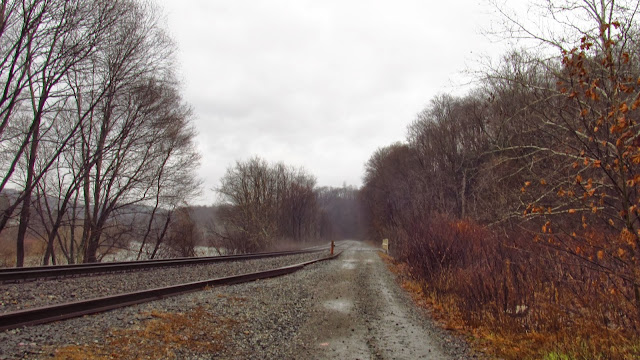 |
Heading up the current Norfolk Southern tracks from Salina.
|
 |
Misty, foggy river.
|
 |
Nice waterfall along the tracks. Probably not much of a waterfall when the weather is dry though.
|
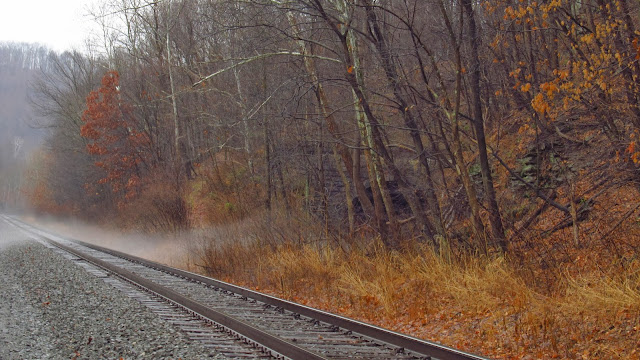 |
Approaching the west portal of the tunnel.
|
 |
Work was begun on this portal in June, 1882.
|
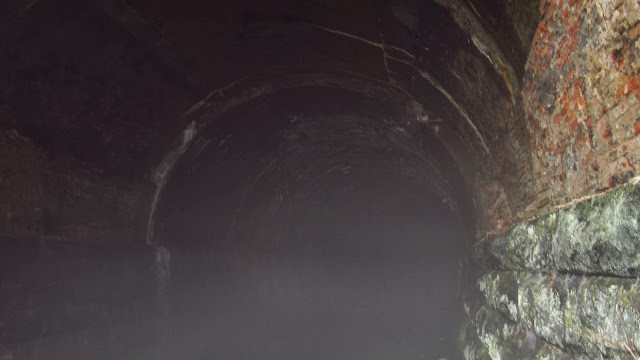 |
A look inside. There was about 8 inches of water in this section. I wasn't going through it.
|
 |
Some brickwork.
|
 |
The masonry is still so intact after 131 years. This stuff was built to last.
|
 |
Heading down the tracks looking for the eastern portal. The current Norfolk Southern bridge coming up.
|
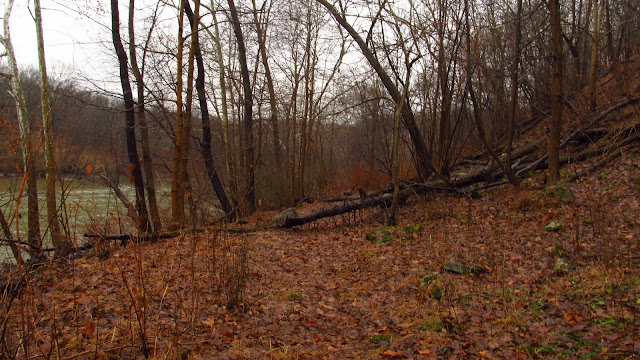 |
I took this trail right before the bridge. It runs below the Avonmore Branch.
|
 |
Some railroad ties that fell down the hill from the Avonmore Branch.
|
 |
Looking up at the remains of the Avonmore Branch.
|
 |
Piers remaining in the river from the bridge.
|
 |
Finally reaching the eastern portal. There was a rain drop on my lens. Nothing supernatural here. The bridge above the tunnel is part of the Avonmore Branch.
|
 |
A closeup of the pier from the western abutment.
|
 |
Looking inside. Still a rain drop on the lens.
|
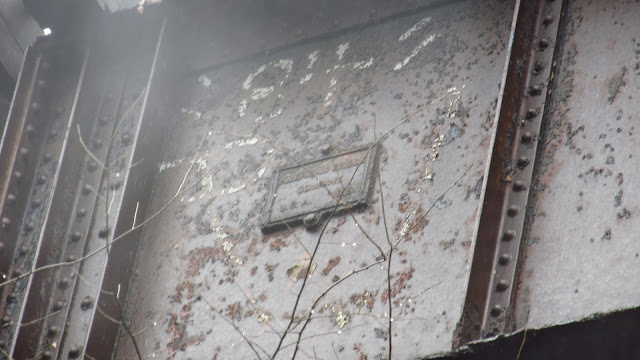 |
Looking up at the bridge for the Avonmore Branch. It was hard to get a good angle on this plaque but zooming in you can see it was built by the American Bridge Company, of which the company town of Ambridge, PA got its name. The date looks like 1915 but it's hard to make out.
|
 |
Let's go inside the tunnel. No flood here.
|
 |
Looking out. The masonry didn't hold up so well on the eastern side.
|
 |
Going deeper into the mountain.
|
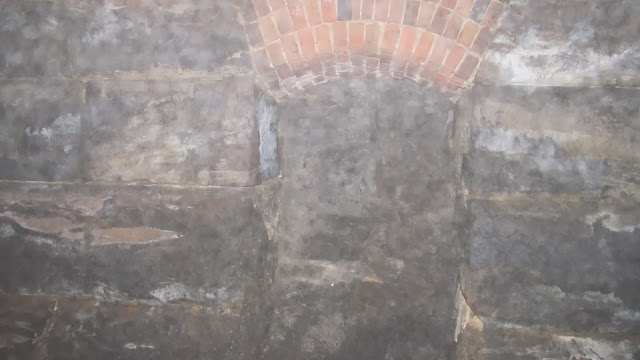 |
Photos were really tough to get in here due to the fog. The flash on the camera reflected right off of it. This is one the manholes on the southern side of the tunnel. I'm assuming these were placed here to jump into when a train was coming through. I would imagine a tunnel full of smoke from a steam engine was not very pleasant at all. Hey, at least you didn't get run over but you probably suffocated.
|
 |
Following my spotlight onto the brick work.
|
 |
This is how the photos turned out when I used the flash.
|
 |
More brickwork.
|
 |
Deep inside the mountain.
|
 |
A little bit of the tunnel in daylight.
|
 |
The pile of rubble.
|
 |
It amazes me how tight this block still is.
|
 |
Pier.
|
 |
Norfolk Southern train passing over the current bridge.
|
 |
The tunnel and Avonmore bridge from the abutment.
|
 |
Old utility pole on the Avonmore Branch.
|
 |
Heading across the Kiskiminetas into Armstrong County on the current bridge.
|
 |
Looking over at the foggy bridge piers.
|
 |
I passed under this bridge to get to the Armstrong County side of the old bridge.
|
 |
Looking across the river at the eastern portal and the bridge piers.
|
 |
The old main line is all overgrown.
An interesting piece of history about the tunnel and bridge. On Dec. 24, 1906, at 5:00 PM at the east end of the tunnel, a train accident occurred. A train hauling a huge shipment of structural steel or iron on twin cars (the load being so large that it has to be hauled on two cars) had an incident while turning a bend. One of the two fastenings gave way and caused the load to shift to the right, far enough to scrape quite severely the brick arch in the tunnel all the way through.
Coming out of the tunnel, the load caught the framework of the bridge with such force that it pushed the entire bridge off its west abutment. This caused eight cars of the train to plummet into the river in a huge mass of ruins. None of the train crew were on any of these cars and nobody was hurt.
West Penn Railroad Superintendent R.I. Morrow immediately had arrangements made to reach the wreck site via a special train. In addition to the West Penn crew, he summoned two carpenters from the main line and also a crew from the River Division of the B & A.V. Railroad. A kitchen car was sent from Altoona with enough provisions to keep the crew fed, enabling them to work around the clock. The west bound track was back in service just 43 hours after the accident.
During the obstruction, the passenger, baggage and express traffic was routed over the Avonmore Branch. At the point where the county bridge led to Avonmore Station, the train picked up the baggage and express matter after it was moved across the bridge by wagon.
By Friday, December 29 at noon, both tracks were again opened to traffic.
|
Update 7/30/2014
These are just a few photos of the old railroad piers from the river.






